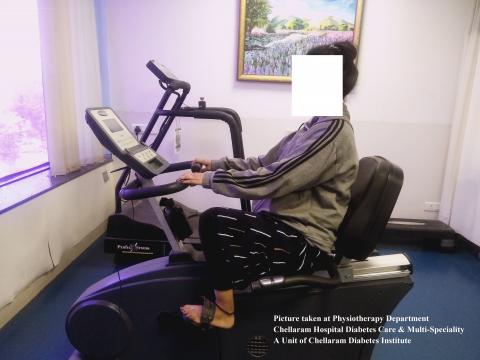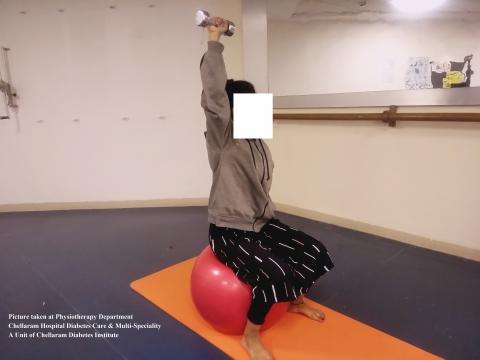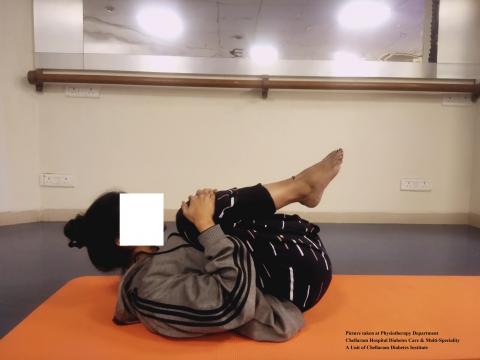
Consulting Physiotherapist Nikita Morwal Kataria at Chellaram Hospital Diabetes Care and Multispeciality, Pune highlights the benefits of exercise for diabetes and helps you identify exercises good for diabetes management.
In today’s chaotic world, it has been seen that increased sedentary behaviour greatly affects the health outcomes such as risk of obesity rates rising, lowered cardiorespiratory fitness and lowered insulin sensitivity in young people especially aged between 11-18 years old. It has been predicted that about 4.1 million children and young people who are obese and overweight globally are likely to remain obese and overweight into adulthood leading to a greater risk of developing non-communal diseases such as diabetes and cardiovascular conditions at a younger age.
Benefits of exercise
A few benefits of doing regular exercise for overall health with specific benefits related to diabetes management are as follows:
- Helps maintain a healthy body weight
- Helps improve blood circulation
- Managing blood glucose levels thereby reduce the amount of medication
- Lowers blood glucose levels and boosts your body's sensitivity to insulin, countering insulin resistance.
- Reduces the stress level
- Controls Blood pressure and reduce the risk of heart disease
- Lower harmful LDL cholesterol and triglycerides, raise healthy HDL cholesterol
- Improves strength, flexibility and overall well being
- It has been seen that Type2 diabetes is closely associated with body weight, and nearly 90% of newly diagnosed are above their ideal body weight. People with diabetes and obesity are at higher risk for heart diseases like diabetic cardiomyopathy.
Find exercises that you enjoy
Exercise doesn’t always mean taking up a gym subscription; you can do your exercises as per your comfort even at home or make use of the environment around you (for example terrace/ parks/ garden/ beach etc). All you need to do is to find an exercise that you will enjoy doing; because if you don’t enjoy the exercises, then it’s difficult to keep yourself motivated despite knowing the exercise benefits and you will not be consistent with them.
Everybody should try to engage themselves in exercises for at least 30 minutes every day for 5 days in a week, to maximize health and quality of daily life, be it cardio workout/ aerobics, resistance/ strength building, stretching/ flexibility exercises and balance-agility training.
Initially try to aim at least 20-30 minutes cardio (aerobic) exercise for at least 5 days a week. This may include walking (not brisk for patients having peripheral neuropathy)/ skipping (those who do not have any joint pain like knee pain)/ jogging (**walking, skipping jogging to be done wearing appropriate shoes) or swimming (make sure to wipe feet and toes properly after swimming), cycling/stationary cycle, marching at place or spot jog. If you are finding it difficult to find 30 minutes in your busy schedule, then you can split the session in 2 bouts of 10-15 minutes (one in morning & evening)

Stretching exercises:
Stretching exercises are a part of flexibility training and should be done before and after workout session for 10 minutes. It helps to improve the functioning of your muscles and joints, reduces the muscle soreness and relaxes the muscles.
Resistance Training:
Once you have set this routine of aerobic and flexibility exercises, you can start including some resistance or strength training/ weight training in your exercise regimen. This necessarily need not include lifting weights, instead you can use your own body weight in the form of pull-ups or planks etc. Self-resistance exercises for muscle strengthening can also be easily done at home in the form of wall push-up, sit-ups, squats, planks, reverse planks, pull ups etc. in a set or two of about 10-12 repetition, at least thrice a week. Learn to do these under the guidance of a physiotherapist. Let your physiotherapist know if you have knee pain/arthritis, severe low back pain, hernia etc. so that exercises can be modified.

Strength Training:
In case you are starting weight training at gym, make sure you seek help of a gym staff/personal trainer. To get sufficient benefit of strength training, lifting weights 20-30min for 2-3 times a week is sufficient. (do not forget to warm up prior and cool down after workout)

Yoga for diabetes management
In recent times, Yoga practice is also playing a vital role in diabetes management, and in the case of type 2 diabetes, it prevents the disease from developing by:
- Rejuvenating the pancreatic cells- it has been seen that certain yoga postures aid relaxation and stretch the muscles and soft tissues in the region of pancreas, that can stimulate the production of insulin producing beta cells.
- Yoga has shown to increase the glucose uptake by the muscles, improve the blood circulation, helping to lower the blood sugar levels, also reducing the cardiovascular risk factors.
- Maintaining a healthy body weight by regular practice of yoga can be achieved, which is essential for protecting against type 2 DM, various heart disease, Thyroid etc
- Regular yoga practice can help to keep the mind positive and create the right mental approach while dealing with diabetes
- Pawanmuktasana, Shashankasana, Ushtrasana, Padahastasana, Bhujangasana (Cobra Pose), Setubandhasana (Bridge Pose) are few yogasana that can be regularly practiced under guidance for maximum benefits in Type 2 DM
Suryanamaskara (Sun Salutation)
- Regular practice of suryanamaskara is known to give a number of health benefits. It helps to balance the metabolism. It stimulates and balances all the systems of the body, including the reproductive, circulatory, respiratory and digestive systems. It also has influence on the endocrine glands, maintaining balanced hormonal secretions.Hence it is said that when practice of suryanamaskara is started at young age, it helps to balance the transition period between childhood and adolescence during the growing years of children giving maximum benefit physically and mentally.
- The practitioner has to focus precisely on the breathing pattern while moving from one step to the other step of suryanamaskara. This synchronization of the breath with each pose, ensures that the person breathes as deeply and rhythmically as possible, increasing mental clarity by bringing fresh, oxygenated blood to the brain.
Mindfulness increases glycaemic control
Mindfulness and breath awareness techniques are now widely being practised for managing stress and anxiety not only in patients but also in normal individual as well, for having better mental and emotional wellbeing. The daily monotonous routine can make us less productive, fading our passion for work, and we tend to become more stressed, thereby withdrawal and isolation creeps in. Some organizations are promoting mindfulness training for employees, while many school systems and training organizations have also incorporated mindfulness in their curricula.
A research study found that a regular mindfulness practice can have a significant impact on reducing sleep disturbance and can improve the quality of sleep. Mindfulness practice has been shown to increase glycaemic control and subsequently reduce chances of having hypoglycaemic, hyperglycaemic episodes leading to a reduction of the mental distress associated with diabetes.
Mindfulness is subjective and is a self-experience by itself. Try this 5-minute breathing technique to cultivate mindfulness:
- Simply sit or even lie down in a comfortable position, resting your hands and arms in relaxed manner
- Try to observe the pattern of inhalation and exhalation with each breath
- Focus on the breathing pattern wherever it is most prevalent, either at nostrils, or the rise and fall of chest or abdomen, how deep or shallow it is
- Though there would be other thoughts in mind, or you could hear the sounds from the surroundings, or even notice fragrances/smells, but try to keep observing your breathing
- Accept all these various sensations that occur with gratitude and bring your focus back to breath
- Breathe in, slowly, gently, deeply, and breathe out.
Practice this technique for a few minutes regularly. You can also practice it during work sessions, prior to a meeting, or before going to bed. Let this be integrated in your day to day life so that it enhances your ability to completely attend work without getting distracted. Mindfulness is a practice which helps you to find a sense of balance in life, and also fits into your lifestyle, cultivating positivity and connecting to your inner self.
Finally - sit less, move more
Lastly I would say that making your exercise regime a priority would help your body and mind function efficiently. Remember, your health in the long run depends on what you decide to start today, and stay committed to it. Sit less, move more and keep yourself fit and healthy.

Consultant Phsyiotherapist Nikita Morwal Kataria
(All pictures taken at Physiotherapy Department, Chellaram Hospital Diabetes Care & Multi-Speciality A Unit of Chellaram Diabetes Institute.)







